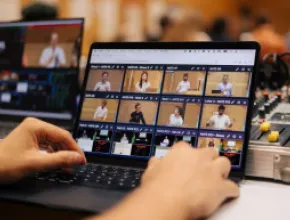By Corbin Ball
© 2012 Corbin Ball Associates
As the use of mobile event apps continues to explode, there is an increasing demand by attendees to have easy-access, barrier-free and, hopefully, cost-free Wi-Fi in the meeting space and in sleeping rooms. Consider these statistics:
· Free in-room Internet access ranked as the most desired guest-room amenity. -- Synovate survey, 2011, 6,300 people, 10 countries
· 47 percent of respondents said a hotel must cater to their technology needs before they book it, with wireless access a top priority. -- Synovate survey, 2011, 6,300 people, 10 countries
· Internet access is at the top of things most guests care about hotels (including luxury, upscale, mid-scale full-service, economy/budget, and extended stay properties) -- J.D. Powers Survey, 201
· Free Wi-Fi affects the choice of venue (64% yes; 31% maybe/depends on other factors as well; 5% no) – InStat survey, September 2010
Increasingly, meeting attendees are carrying around one or more wireless internet-enabled devices. They are business travelers and expect to check email, use social networks (40% of all tweets are mobile), and wish to take advantage of a wide range of mobile meeting and travel apps. For international attendees, the cost of roaming fees is often prohibitively expensive. Wi-Fi is their lifeline to stay connected.
With this growing need and demand by attendees, planners are pressing venues for free event Wi-Fi and are making this a key criterion for venue selection. Associations such as ABPCO (Association of British Professional Conference Organisers) have a country-wide initiative to promote free basic conference Wi-Fi for attendees (see www.theconferencecloud.co.uk for details).
The Challenges:
There are many issues involved:
· 60% of travelers in the US, Europe and Australia indicate they already have had a poor hotel downloading experience because the system was slow. -- Ttnooz, Nov. 2011
· Many facilities are unable to keep up with the demand. The 2011 Consumer Electronics Show (the world’s largest technology show) asked attendees to turn off their phones and Wi-Fi to enable access for the keynote presenters.
· The demand for broadband is exploding for many events. For example, 5,000 attendees consumed one terabyte (one thousand billion bytes) of data via Wi-Fi in four days at the London Frieze Art Fair, Oct. 2011. This is one example of many.
· 90% of meeting professionals have smartphones and/or iPads/tablet computers and 62% use their apps constantly throughout the day (M&C Research Survey, December 2011).
· A November 2011 white paper by iBahn, a major hotel internet provider, notes that 25% of devices on their network are iPads. These video streaming and media consumption devices use 400% more data that the average iPhone,
· 25 million iPads have been sold as of June 2011 (UnwiredView) and an amazing 5 million Wi-Fi only Amazon Kindle Fire tablets are estimated to have been sold in the last three months of 2011(J.P. Morgan, December 2011).
· This explosion of iPad and other tablet computer is driving bandwidth requirements to what is felt by some hotels to be unsustainable levels. To quote David Garrison, iBahn CEO in the November 2011: “The iPad is the final nail in the ‘all internet is free’ coffin.”
· There is a big discrepancy between event organizers and venue managers on whether attendees should receive free Wi-Fi: 90% off organizers say yes while only 48% of facility managers replied favorably (IAEE Survey, July 2011).
· 64% of venue managers and CVB stakeholders feel that show managers have unrealistic expectations when it comes to what they want and are willing to pay for regarding event Wi-Fi (Red 7 Media, Summer 2011).
Some solutions:
The facts are that the Wi-Fi at many venues is not satisfactory (it sucks!) and with increasing bandwidth requirements things are getting worse. What can or should be done?
Here are some recommendations:
· Meeting venues need to plan on high double-digit annual growth in Wi-Fi bandwidth requirements at least for the next five years. The good news is technically this is completely feasible. According to Ian Bull, Head of Sales Business Development for the Wireless Technology Group for Cisco, there is “significant growth potential for Wi-Fi using micro cells and Wi-Fi Hotspot 2.0 technology. Even very large venues with thousands of simultaneous users can be managed in a way that good quality wireless internet signal can be provided.”
· Venues must step up to the plate and build the infrastructure for this growth. This will increasingly be the deciding factor in venue selection.
· Meeting venues should provide detailed assistance to meeting planners to help them determine the Wi-Fi and internet requirements. It is not enough to reply “yes we can provide Wi-Fi.” Many questions need to be asked, such as: Wireless internet for how many people simultaneously? On what devices? For what apps? In what locations? How much bandwidth is needed? Venues must know their capabilities and limitations well and communicate them to clients.
· Meeting planners also must educate themselves as well to the specific needs of their attendees, their expectations, their internet requirements, and must be very clear to venues about what they expect in detailed requests for proposal.
Dealing with Costs:
· A major challenge is cost. Meeting venues are for-profit entities and the demand for internet services is growing exponentially. How can these costs be offset or limited?
Here is my view:
· Venues should provide basic, mobile-friendly Wi-Fi internet access (512kb/s) throughout the entire facility (sleeping rooms/lobby/meeting rooms/exhibit hall) for free without the need for extensive log-in procedures. 512kb/s is fast enough to check email, tweet, and do some basic web browsing but not fast enough to stream HD video, download audio files, etc.
· Provide a reasonable rate “premium service” for attendees who desire more speed.
· Charge reasonable rates for specialized services: dedicated bandwidth, dedicated IP address, VPNs, specialized exhibit services, etc. As an example, the Las Vegas Convention Center (one of the largest in the world) in November 2011, launched their internet service plan: free for basic service, $13/day for premium service, and $100 for exhibitors.
· Another option to offset costs is for meeting planners to solicit internet sponsorship. Internet access and mobile apps have many opportunities for splash page or banner ad sponsors. These page views are completely trackable and can provide great visibility to attendees using a much desired service.
· With the increase in smart phones and tablets, cyber-cafes are going the way of the banks of pay phones. Divert the sponsorship funds and other monies spent on these services to help offset the cost of attendee internet access.
· Venues should also look for sponsors. Meeting attendees spend money at nearby establishments. Many of these businesses would likely be willing to pay for advertising space on conference Wi-Fi services to gain visibility.
· Planners, exhibitors and attendees should expect to pay for premium internet services. Venues are for-profit entities and have every right to charge to cover costs at the minimum. However, planners and attendees should not be gouged with exorbitant fees. Hotels, convention centers and other venues should not consider internet services a major profit center any more that they consider providing lights and water for attendees and guests – Wi-Fi has become an expected utility.
· The price gouging employed by a number of upper mid-scale and luxury hotel properties (i.e. US$9.95/day/each device) must stop! Planners and hotel guests commonly will be making venue decisions based on fair policies for internet access.
Wi-Fi challenges will likely get worse before they get better. The increasing demand will exceed the supply as venues struggle to upgrade their internet infrastructure. It will be incumbent on all venues to gear up for these increased bandwidth demands. It will also be important for planners, exhibitors, attendees and venues to educate themselves on the issues and help each other find the optimum way for providing Wi-Fi for events. As Wi-Fi increasingly becomes the communication life-blood of events, we will all need to work toward optimal solutions.
Corbin Ball, CMP, CSP is a professional speaker and consultant focusing on meetings technology. With 20 years of experience running international citywide technology meetings, he now helps clients worldwide use technology to save time and improve productivity He can be contacted at his extensive web site: www.corbinball.com and followed on Twitter: www.twitter.com/corbinball





